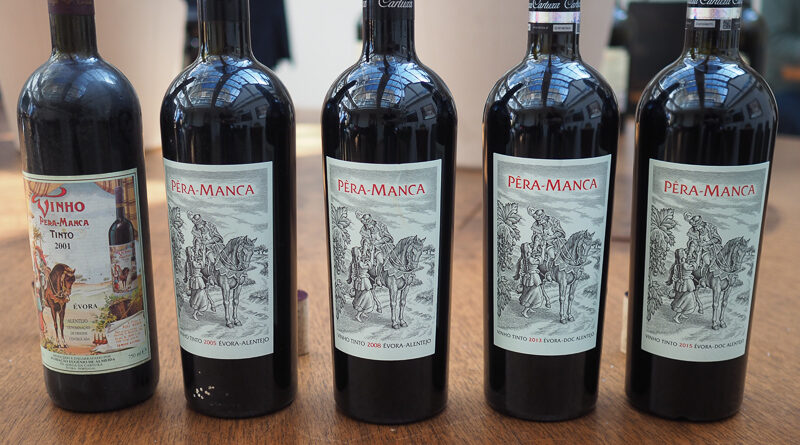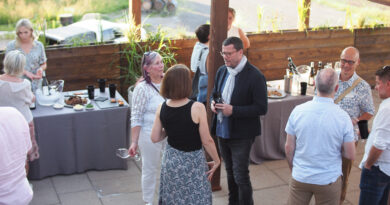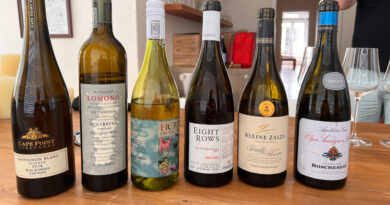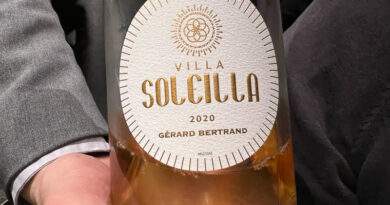Pêra-Manca vertical tasting: tasting multiple vintages of this cult Alentejo (Portugal) wine, plus others from the Cartuxa portfolio
Pêra-Manca is the name for the ‘cult’ red and white wines made by large Alentejo producer Adega Cartuxa, which since 1963 has been owned by the Eugénio de Almeida Foundation. This was set up by Vasco Maria Eugénio de Almeida with a mission to promote cultural, educational, social and spiritual development of the region of Évora, and one of the main ways this is done is through the Cartuxa winery, which has 560 hectares of vineyards (with land of 6500 hectares) in the Évora region.

Pêra-Manca was a famous wine brand in the 19th Century, and the combination of phylloxera and the death of the owner meant that this wine wasn’t made from 1920 onwards. After some experiments in the 1970s and 1980s making a a high-end wine, Cartuxa were given the trademark by the owners they resurrected this once-famous wine in 1990 in both red and white forms. Pedro Baptista, the Cartuxa winemaker, was in town showing a vertical of both, alongside some other wines.
I asked him about the journey that let them to recreate this wine, which happened before his time as winemaker. ‘At the time I was at university. This rebirth began in the 1970s and 1980s at the Cartuxa winery, when we were studying the genetics of some grape varieties, and we began planting these grape varieties in different situations. At the end of the 1980s the people who at the time were responsible for viticulture and winemaking achieved some results with some plots of Antão Vaz and Arinto for whites and Trincadeira and Aragonez for reds, that made them thing they could make a special wine. In 1987 the first Pêra-Manca was born, but in fact it wasn’t a Pêra-Manca Manca, it was a Cartuxa Garrafeira. Between 1987 and 1990 the family that owned the Pêra-Manca trademark offered it to the foundation. After 1990 we started to bottle the result of this hard work of research as Pêra-Manca. It’s a wine that has centuries of history, but we have been making it since 1990.’
The white is vinified in barrel, and the reds are made in large tanks of French oak with 45-60 days’ maceration post-ferment and after that ageing for 18 months in 3500 litre large-format oak.
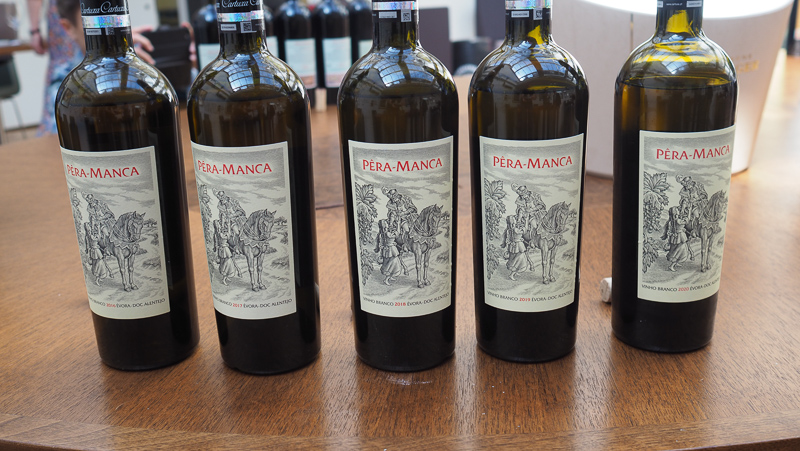
Pedro started at the foundation in 1997 as a viticulturist, and since 2004 he has been the chief winemaker and also in charge of the viticulture.
The market decides the price of these wines, and it isn’t common to find a bottle of the red in the market for less than €400. They don’t sell directly to customers unless they visit the winery. ‘We like that people who take a bottle of Pêra-Manca know the winery,’ says Pedro. Visits aren’t expensive: the cheapest is €5 and you still get the chance to buy Pera Manca. There it costs €295 for the red and €50 for the white.
Originally Pêra-Manca was released with the old label, but they have since updated this with an elegant woodcut that isn’t quite so kitsch, and it’s bottled in a heavyweight bottle. Production is between 20 000 and 30 000 bottles of the red, with around 90 000 bottles of the white. The red is only made in the best vintage, while the white is made every vintage.
For their amphora wines they have 15 talhas from 1886. They use them, and they use pez (a traditional lining including resin and wax), which adds some character to the wines. They leave the wines on skins until November (this is necessary for the Talha DO), they take the skins out and then put the wine back into the cleaned talha for another six months.
THE WINES
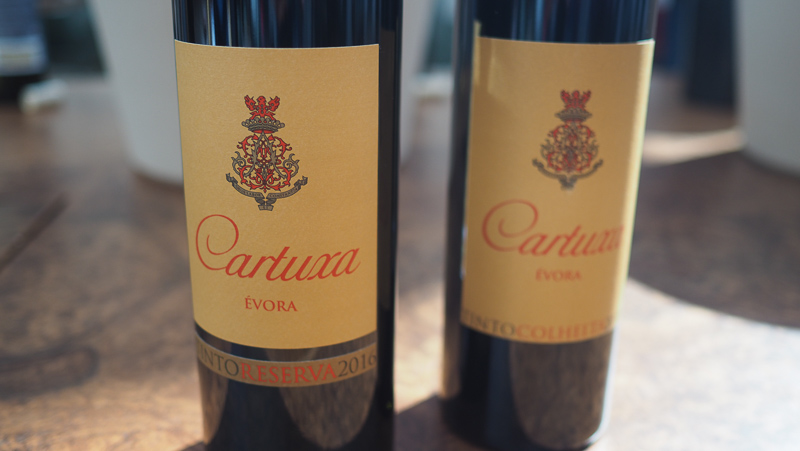
Cartuxa Tinto Reserva 2016
14.5% alcohol. Made from old vineyards, ageing 15 months in new French oak. Complex and grainy with nice spicy detail to the rich, voluminous red cherry and berry fruit. There’s freshness here with some gravelly detail, and an almost chalky character to the red fruits. Manages to balance intrinsic richness and warmth with freshness, and the fruit and savoury elements work in nice harmony. 94/100
Cartuxa Tinto Colheita 2018
14.5% alcohol. A blend of different varieties each vinified separately, withFresh and sappy with sweet cherry and raspberry fruit, backed up by some spicy detail. Lovely fruit focus here: it’s sweet, textural, silky and also spicy, with great balance and no jamminess. Finishes bright with a twist of pepper. Quite lovely. 94/100
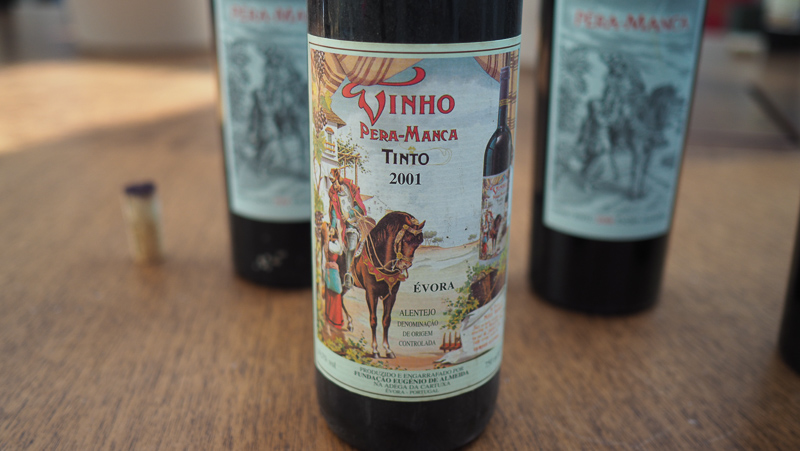
Pêra-Manca Tinto 2001
14.5% alcohol. Some fading at the rim of this 22 year old wine. Lovely evolution here: mellow and mature with a hint of malt and fine earth, as well as sweet strawberry and raspberry fruit. Nice complexity and a real mellow maturity with nice depth. Classy stuff for drinking now. 95/100
Pêra-Manca Tinto 2005
14.5% alcohol. Lovely aromatics with a spice, cedar and dried herb twist to the sweet berry fruits. The palate has warm, ripe, smooth fruit and a sense of harmony, finishing with a bright cedary, spicy edge and some tannic grip. Warm and harmonious with nice depth of fruit. Has a sweet core to it. 95/100
Pêra-Manca Tinto 2008
15% alcohol. There’s an innate density and depth to this wine, with bold, sweet cherry and berry fruit. Nicely intense with a tarry, spicy, cedary twist to the plush fruit. Has some fine herbs and spice, showing lovely depth. A bit grippy, too. Complex and refined. 95/100
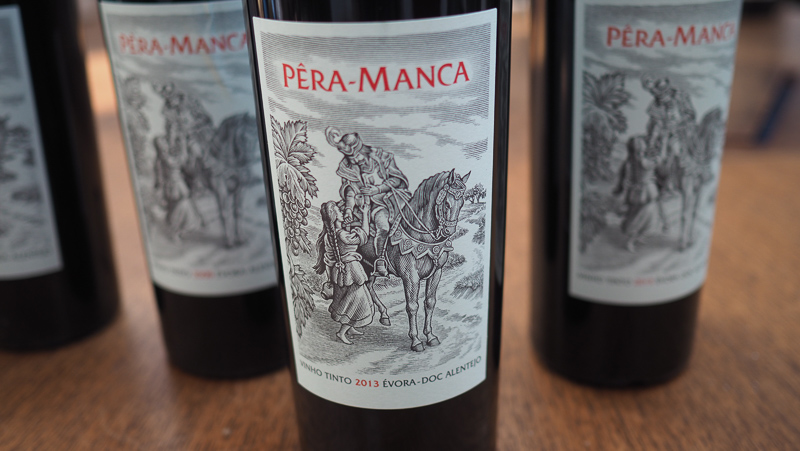
Pêra-Manca Tinto 2013
14.5% alcohol. Concentrated with sweet, pure red cherry and raspberry fruit with some lovely fine-grained tannins. This has depth and power, but there’s a softness, too – the elevage has resulted in a beautifully lush wine, but it has stayed on the right side of jamminess, and offers layers of red fruits with a plush, rich personality. Drinkable now, and really appealing, but it will age further into a soft, mellow maturity. 96/100
Pêra-Manca Tinto 2015
14.5% alcohol. Dense, focused and with some firm tannic structure under the bold, sweet raspberry and cherry fruit. Impactful and intense, this is currently firm and sinewy, and needs some time to resolve. Lots of promise for the future: a very ripe wine, but an ageable one. 95/100
Cartuxa Branco 2019
13% alcohol. Fleshy but bright at the same time with appealing vivid citrus fruit, with some orange peel notes and a twist of mandarin, finishing with a nice fine spicy flourish. Nicely expressive with lovely fruit focus. 93/100
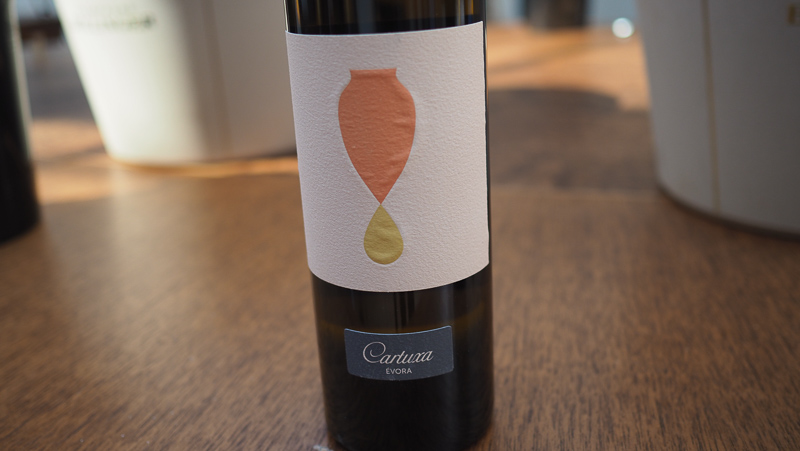
Catuxa Vinho de Talha Branco 2018
14% alcohol. Full golden colour. Rich but well defined with notes of pear and apple, showing nice richness. Has some spiciness and also a touch of pear and peach, with lovely density. Lots of personality here. 93/100
Pêra-Manca Branco 2016
13.5% alcohol. Full yellow colour. Lovely aromatics of pear, peach, spice and wood with as slight smoky edge. Bold, rich and full on the palate, and quite harmonious, with nuts and spice and rich, bold fruit with some savoury notes in the background. Has a distinctive spicy finish. Despte the richness and depth, there’s freshness here on the finish. 93/100
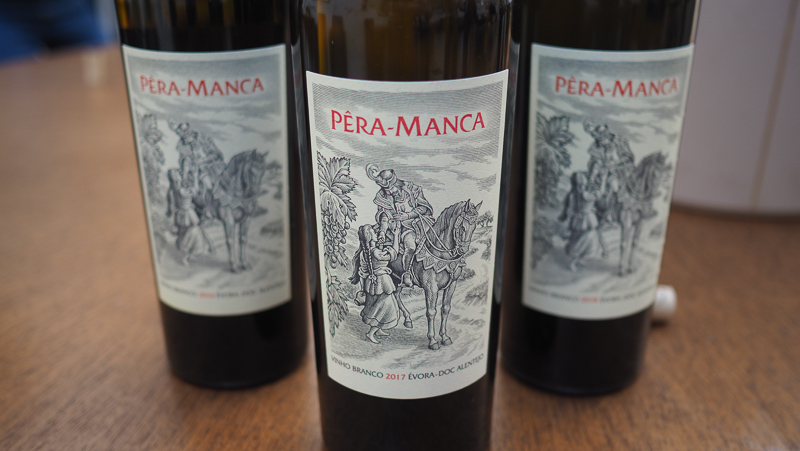
Pêra-Manca Branco 2017
13% alcohol. Lovely focus and intensity to this rich, finely spiced wine. There’s a lovely acid line under the sweet pear and peach fruit with nice intensity and depth. There’s a lot of concentration and flavour here with lively spicy notes and a nice acid line, as well as warmth and richness. 94/100
Pêra-Manca Branco 2018
13% alcohol. Lovely fruit intensity here: fresh pear and peach with some citrus. Nice spicy hints with freshness as well as depth. Bold pear and white peach on the palate with some nice spicy notes, showing. Lovely rich fruit here supported by some fine spicy notes. Impressive stuff. 94/100
Pêra-Manca Branco 2019
13% alcohol. Fresh with really good acidity, showing a spicy, limey streak that underpins the bold, ripe pear fruit. Nice intensity here with some juiciness. Has great concentration and depth, and admirable freshness. Impressive. 95/100
Pêra-Manca Branco 2020
13.5% alcohol. Lively, bright, taut and intense, with a pithy edge to the vivid citrus fruit. There’s a nice acid line here. Currently youthful and compressed with nice weight and balance, and the potential for development. Lovely intensity here. 94/100
See also: the wines of Cartuxa

